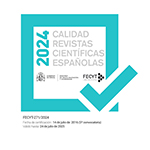Las Cecrópidas como imagen representativa de las madres en Atenas arcaica y clásica
Resumen
Generalmente se ha pensado en las Cecrópidas, las hijas del Rey serpiente Cécrope, estrechamente vinculadas a la acrópolis, como imagen de las niñas y de las jóvenes (parthenoi) en sus procesos de iniciación y de tránsito hacia la madurez (Burkert, Brulé), y ésta es, quizás, la imagen más visible de las jóvenes heroínas en Atenas. Sin embargo, no se ha tenido, quizás, tan presente su importancia, al mismo tiempo, como icono de las madres ciudadanas en esta polis en varios aspectos que son esenciales para su identidad social y religiosa. Uno de ellos es la curotrofía o el cuidado de los niños, lo que va de la mano de la labor educativa de las madres y de su importancia en la transmisión de la tradición de Atenas. Otro de estos aspectos es el papel de las mujeres adultas, casadas, como responsables y dirigentes en tareas religiosas fundamentales para la continuidad y supervivencia de la ciudad, como el cuidado de la estatua de la diosa, el tejido del peplos panatenaico o la administración y el cuidado del tesoro y de los espacios sacros acropolitanos. Junto a las Cecrópidas, también las Eréctidas desempeñan un papel esencial de reproducción y de transmisión de la herencia cultual, religiosa y “autóctona” de la ciudad, lo que caracteriza, asimismo, a las madres de Atenas.
Descargas
Descarga artículo
Licencia
La revista 'Ilu. Revista de Ciencias de las Religiones, para fomentar el intercambio global del conocimiento, facilita el acceso sin restricciones a sus contenidos desde el momento de su publicación en la presente edición electrónica, y por eso es una revista de acceso abierto. Los originales publicados en esta revista son propiedad de la Universidad Complutense de Madrid y es obligatorio citar su procedencia en cualquier reproducción total o parcial. Todos los contenidos se distribuyen bajo una licencia de uso y distribución Creative Commons Reconocimiento 4.0 (CC BY 4.0). Esta circunstancia ha de hacerse constar expresamente de esta forma cuando sea necesario. Puede consultar la versión informativa y el texto legal de la licencia.











